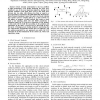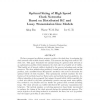ICCAD
2010
IEEE
13 years 2 months ago
2010
IEEE
Clock network construction is one key problem in high performance VLSI design. Reducing the clock skew variation is one of the most important objectives during clock network synthe...
FPGA
2006
ACM
13 years 8 months ago
2006
ACM
This paper examines the tradeoffs between flexibility, area, and power dissipation of programmable clock networks for FieldProgrammable Gate Arrays (FPGA's). The paper begins...
ICCAD
1993
IEEE
13 years 8 months ago
1993
IEEE
We have proposed an e cient measure to reduce the clock skew by assigning the clock network with variable branch widths. This measure has long been used for \H" clock tree. T...
ISLPED
2003
ACM
13 years 9 months ago
2003
ACM
A significant fraction of the total power in highly synchronous systems is dissipated over clock networks. Hence, low-power clocking schemes would be promising approaches for futu...
ISPD
2005
ACM
13 years 10 months ago
2005
ACM
In the nanometer VLSI technology, the variation effects like manufacturing variation, power supply noise, temperature etc. become very significant. As one of the most vital nets...
ASPDAC
2005
ACM
13 years 10 months ago
2005
ACM
: In ultra-deep submicron VLSI circuits, clock network is a major source of power consumption and power supply noise. Therefore, it is very important to minimize clock network size...
ISLPED
2006
ACM
13 years 10 months ago
2006
ACM
—The thermal gradients existing in high-performance circuits may significantly affect their timing behavior, in particular, by increasing the skew of the clock net and/or alteri...
ICCAD
2006
IEEE
13 years 10 months ago
2006
IEEE
Abstract—Power/ground noise is a major source of VLSI circuit timing variations. This work aims to reduce clock network induced power noise by assigning different signal polariti...
FPL
2007
Springer
13 years 10 months ago
2007
Springer
The programmable clock networks in FPGAs have a significant impact on overall power, area, and delay. Not only does the clock network itself dissipate a significant amount of powe...
VLSID
2007
IEEE
13 years 10 months ago
2007
IEEE
As the VLSI technology scales towards the nanometer regime, circuit performance is increasingly affected by variations. These variations need to be considered at an early stage in...



